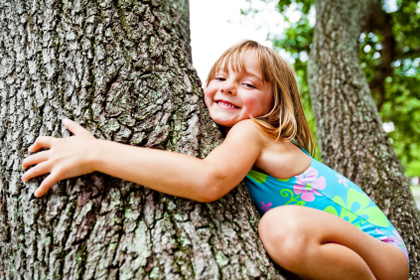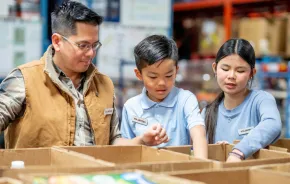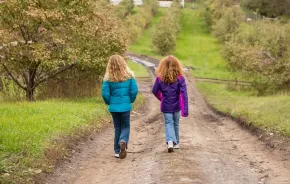 When it comes to green living, Seattle mom Kathy Cowles considers her family pretty typical: They recycle and compost, avoid meat, buy organic and local foods, and use public transit whenever possible.
When it comes to green living, Seattle mom Kathy Cowles considers her family pretty typical: They recycle and compost, avoid meat, buy organic and local foods, and use public transit whenever possible.
But to friends and relatives in other cities, the family is the epitome of eco-consciousness. Seattle’s characteristic green mindset isn’t the norm in other cities, she says. “I feel like we’ve done the basic, obvious things to minimize waste and conserve resources. But there’s an environmental awareness here that we kind of take for granted.”
It’s true that Seattle’s image is as green as the moss that inhabits Northwest backyards, and with good reason. The city is a national leader in recycling and hydropower, and scores major points on many “green cities” lists. But contrary to long-held beliefs, the region isn’t the country’s greenest — other towns surpass Seattle in key metrics such as walkability and transportation emissions.
Does Seattle deserve its ecological accolades, or is the grass truly greener in other cities? And how can local families help to keep the Emerald City green?
Green living roots
What does it mean to be green? For most of the industry’s thought leaders, “green” means sustainable. Seattle-based sustainability think tank Sightline Institute includes “carbon neutrality, hyper-efficient use of natural resources, zero-pollution industries, and low-stuff, high-satisfaction lives” in its definition of sustainability. It’s a lofty goal that no Northwest city has reached, according to Sightline.
But Jill Simmons, director of Seattle’s Office of Sustainability and Environment, touts Seattle as a national front-runner in the green race. Like Cowles, she knows that Seattle’s environmental policies and practices aren’t nationwide norms. “Much of what we take for granted in Seattle, other regions are just beginning to work on,” she says, citing the city’s robust recycling and composting program as an example. “In other major cities, it’s much harder for recycling programs to get traction, in part because garbage pickup costs are rolled into property taxes. But people in Seattle have paid for garbage pickup for decades.”
The result is a population that’s motivated to conserve, she says. Indeed, more than 50 percent of Seattle’s waste is either recycled or composted, and the city’s expanded food-waste service helped to quadruple the amount of composted food waste between 2005 and 2009.
Seattle also is making gains on other sustainability goals. As of 2010 (the last year for which many records are available), Seattle was on track to meet its goal of emissions 7 percent below 1990 levels. The city’s 7-year-old Climate Protection Initiative was a catalyst for significant progress. Within three years of the initiative’s inception, Seattle City Light became the nation’s first carbon-neutral utility. The program’s success has sparked nationwide recognition; in 2007, it earned the Innovations in American Government Award from Harvard’s Ash Institute for Democratic Governance and Innovation.
Not surprisingly, the Emerald City often vies for the top spot in national rankings of green cities. In its Cascadia Scorecard ranking of Northwest cities, Sightline ranked Seattle second, between top-ranked Vancouver, British Columbia, and third-place Portland. Sustainability guide SustainLane named Seattle the nation’s third-greenest city, behind Portland (greenest) and San Francisco (second-greenest).
But a healthy share of Seattle’s green status is due to historical happenstance, according to Sightline’s research director, Clark Williams-Derry. “Seattle is remarkably green, but it’s largely because of a historical accident,” he says. In other words, Seattle lucked into a moderate climate that allows residents to use less energy for heating and cooling and a vast source of hydropower — renewable energy captured from falling water — that helps catapult it to the top of many “green cities” lists.
So, whether or not Seattle’s grass really is greener depends on what you’re measuring. “There’s a difference between green initiatives and green outcomes,” notes Williams-Derry. “Take New York and Seattle. If you look at green initiatives, Seattle comes out on top in many ways; we have more green space, more efforts to reduce waste and recycle. But for transportation emissions, NYC has far and away lower emissions per capita, while Seattle has a little lower than the national average.” The message: Seattle can’t rest on its green laurels. More work remains.
Walking the eco-friendly walk
Because cars and trucks create 40 percent of the city’s greenhouse gas emissions, one important way Seattle could improve its green status would be to become more walkable, says Williams-Derry. Seattle-based Walk Score calculates a city’s walkability by factoring in things such as walking distance to amenities and road connectivity. In Walk Score’s latest ranking of 50 major cities, Seattle came in sixth, behind New York, San Francisco, Boston, Chicago and Philadelphia.
What can Seattle do to move up the list? “We need more affordable housing in the type of neighborhoods where people can get by without a car, and making streets work that work for everybody, including bikers, walkers, transit, and cars,” Williams-Derry says. Seattle does have highly walkable neighborhoods, such as South Lake Union, Ballard and Capitol Hill, where people can walk to the store or to work, but high demand and limited supply have driven prices upward. “One of the big problems is that people perceive living in these places as more expensive.”
Rankings aside, Seattle is a very walkable, bikable city, and becoming more so all the time, says Simmons. The city’s Walk Bike Ride Initiative, enacted in 2010 by Mayor Mike McGinn, is a blueprint for progress, and the city is steadily making gains, installing more dedicated bike lanes, repairing sidewalks and curbs, and creating more transit routes. Results are encouraging: Since 2000, the number of bike commuters has doubled.
 Generation green
Generation green
One new program is helping to take the green movement into Washington classrooms. Washington Green Schools, a nonprofit program created in 2009, equips teachers and students to make their schools and communities green by supporting sustainability initiatives and education in nearly 200 schools across the state, including 68 in King County.
Any school can sign up for the free government-supported program and receive teacher training, rewards and resources to help schools reduce waste, save energy and create healthier classrooms. Student involvement is a major factor in the program’s success, says co-executive director Meredith Lohr. The program links real-world problems with important educational concepts, such as math, social studies, science and language.
“We do an initial assessment and give kids some responsibility for helping to solve the problems we find. They track the progress, they create presentations. It’s a fabulous context for student learning,” says Lohr. “That’s what motivates schools to get involved — we can show them that we’ll help sharpen the skills they’re already teaching.”
Epidemic rates of childhood health problems such as asthma mean the stakes have never been higher. (The Centers for Disease Control and Prevention reports that one in 10 children now has asthma, and rates continue to climb.) “Research links indoor air quality to absenteeism and asthma,” says Lohr. “We’re helping to make the students and their learning environment healthier, whether by improving air quality or food, or creating greener spaces and planting gardens.”
By helping to conserve energy, the program also helps schools spend less in an era of ever-tightening budgets. “We have schools working on solid-waste issues, doing energy patrols and installing energy-efficient lightbulbs,” says Lohr. The small changes add up. “Our schools save $5,000 a year on average. Imagine if we could do that in every school across the state. We’d save millions.”
Living sustainably at home
What can local families do to help the effort? First, parents can talk to school administrators about health and sustainability in the classroom, says Lohr. “Go on record with your school administration about the importance of reducing waste, conserving resources and creating healthier classrooms.”
Families looking to live more sustainably can use the “triple bottom line” tool employed by businesses. “For businesses, the triple bottom line is people, planet and profits,” says Sightline’s communications strategist, Anna Fahey. “For families, that equates to people, planet and pocketbook. In general, if something is healthy for you and for your pocketbook, it’s going to be good for the planet, too.”
The three main contributors to a family’s eco footprint are housing, transportation and food, says Williams-Derry. So it makes sense to convert to energy-efficient appliances, seal windows and doors to stop heat loss, and reduce unnecessary driving.
But most families can’t afford a whole-house appliance upgrade or a new hybrid car. When families look for small steps they can make quickly, the focus shifts to dietary changes. “You may not be able to afford all new appliances, but you can change your diet, starting today,” says Williams-Derry.
Eating lower on the food chain — more vegetables, and less meat and dairy — makes a big difference to the environment. According to the Environmental Working Group, the production of beef creates twice the emissions of pork, quadruple the emissions of chicken, and 13 times those of beans and lentils.
“Red meat is one of the most carbon-intensive foods you can eat,” says Fahey. “A burger is four times more carbon-intensive than a chicken sandwich.” Families don’t need to cut out all meat, she notes. Eating meatless meals one day a week is a good way to start.
Choosing local foods is another positive step, with one important caveat: For foods that don’t grow well in the cool Pacific Northwest, local doesn’t always mean green, because of the high amounts of energy used in production. Local tomatoes aren’t a better choice if they’re grown in an energy-intensive hothouse; it’s actually better to buy a tomato from someplace else, says Simmons. “We partnered with King County to do a greenhouse gas inventory for goods and services, and we found that most of the emissions are on the production side. Transportation is a relatively minor contributor,” she says.
What about reusable shopping bags, the perennial emblem of the green movement? They’re important, and families should use them, says Fahey. (The Seattle City Council recently passed a broad ban on plastic shopping bags.) But the plastic-bag debate often pulls focus from the real issue: what’s in the bag. “The bag itself is less important than what you put in the bag,” says Fahey. That means more vegetables and less carbon-intensive red meat. “By eating a vegetable-based diet for one day, a family of four saves enough energy to create 186 plastic bags.”
Thanks to schools, community efforts and concerned parents, Seattle kids are growing up with an awareness of sustainability, says Cowles. Environmental issues are a focus at TOPS, the alternative K–8 school her 6-year-old daughter, Ella, attends, and Ella carefully considers whether to put waste into trash, recycling or compost. “I didn’t pay as much attention to this stuff before I had kids,” says Cowles. “Now, I think about the health of the community and the planet when I make choices. It’s important for the health of my family and for the bigger picture.”
Malia Jacobson is a freelance writer and mom of two from Tacoma. She almost never forgets her reusable shopping bags.
Green Living: Getting Kids On Board
Follow these four strategies to get kids excited about living green.
Make it matter. To get kids to buy into the importance of conserving energy, set a family energy-savings goal with a tangible outcome. Pledge to spend some of the savings on a family trip or another treat.
Avoid scare tactics. Young children can be scared by gloom-and-doom images of the world; be sure messaging is age appropriate.
Cook and eat together. Involving children in the preparation of meals builds an appreciation of the importance of nourishing, responsibly sourced ingredients.
Spend time at home. Time spent at home playing games, cooking and doing other enjoyable activities reduces driving and spending, and creates lasting family memories.
Source: Lynda Fassa, author of Green Kids, Sage Families
What’s your family's green grade? Take our online household survey to find out!












